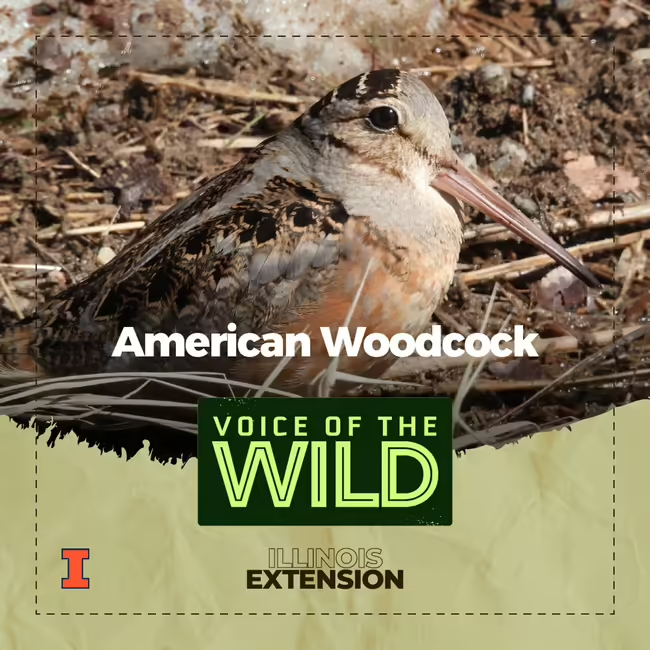
Episode Number
46
Episode Show Notes / Description
American woodcock (Scolopax minor).
The most peculiar of all our shorebirds with a display that is among the surest signs of spring.
Do you want to learn more bird songs, frog calls, and insect noises? Join Voice of the Wild every Friday to explore a new wild voice. We’re available on most podcast platforms, including Apple Podcasts, Spotify, and YouTube.
- Subscription links Here
- Subscribe to the Newsletter
- Listen online on our Homepage
Extras:
- Funny "dance" YouTube video 1: https://www.youtube.com/watch?v=QE-J-O9Y8lA
- Funny "dance" YouTube video 2: https://www.youtube.com/watch?v=UEISiCmjwH8
- Bonus funny video starring a woodcock: https://www.youtube.com/watch?v=bY436JiiCjg
The following Cornell Lab | Macaulay Library recordings were used in this episode:
- American woodcock "peent" call by Wil Hershberger (ML506500)
- American woodcock whistling flight by George B. Reynard (ML506499)
Sources and more:
- https://www.allaboutbirds.org/guide/American_Woodcock
- https://www.audubon.org/field-guide/bird/american-woodcock
- https://bioone.org/journals/Northeastern-Naturalist/volume-23/issue-1/045.023.0109/Note-on-the-Woodcock-Rocking-Display/10.1656/045.023.0109.full
- Dobson C, Kassenbaum D, Oehmke D, et al. 2023. Field guide to hotspots and birds in Illinois. Champaign-Urbana: Scissortail LLC.
- Peterson RT, Peterson VM. 1980. A field guide to the birds : a completely new guide to all the birds of eastern and central North America. Fourth edition, completely revised and enlarged. Boston: Houghton Mifflin Company (The Peterson field guide series ; 1).
- National Audubon Society videoguide to the birds of North America. 2004. Fullscreen. Carrboro, NC: Godfrey-Stadin Productions.
- Sibley D. 2016. Sibley birds East : field guide to birds of eastern North America. Second edition. New York: Alfred A. Knopf (Field guide to birds of eastern North America).
Transcript
This is Illinois Extension’s Voice of the Wild. A new wild voice in just a moment, so find someplace quiet, take a deep breath, and enjoy.
This bird would be merely peculiar judged solely on its “peent” call but the depths of this bird's strangeness are much deeper than that. Despite being solitary and living in woodlands, It is technically a sandpiper and it has their long, probing beak to show for it,. Its eyes are pushed back about as far to the back and top of the head as would be possible without its eyes literally pointing backwards. And of course, it gives a spectacular springtime display to attract a mate- flying upwards into the sky and circling about with whistling wingtips.
This is the American woodcock (Scolopax minor) from the shorebird family, Scolopacidae
The American woodcock sometimes makes an exaggerated rocking motion when it is walking. This was originally interpreted as a method of drawing earthworms out of the soil, but that theory has seen substantial scrutiny. There’s just too many observations of American woodcock doing the rocking display on hard or frozen surfaces where no earthworms could possibly be present.
An alternative to the earthworm idea is that the woodcock is letting you and other potential predators, know that it sees you, and that its therefore no use chasing it. It’d fly away before you could even move a muscle. Either way, the rocking motion is so exaggerated it gives the bird the appearance of doing a funny little dance, and this has gained the woodcock many admirers on the internet. I’ve linked in the description several videos folks have made of the bird dancing to a tune.
For those who would like to appreciate the bird without musical accompaniment, try to find a large forest clearing or open grassland adjacent to scrubby woods, that’s where they like to do their display flights, which typically start around the first of March. If you’re lucky and there’s a park district or Audubon chapter running a woodcock walk near you, this is what you could expect to hear:
Thank you to the Macaulay library at the Cornell lab for our bird sounds. And thank you for tuning in to learn a new wild voice with Illinois Extension.
This bird would be merely peculiar judged solely on its “peent” call but the depths of this bird's strangeness are much deeper than that. Despite being solitary and living in woodlands, It is technically a sandpiper and it has their long, probing beak to show for it,. Its eyes are pushed back about as far to the back and top of the head as would be possible without its eyes literally pointing backwards. And of course, it gives a spectacular springtime display to attract a mate- flying upwards into the sky and circling about with whistling wingtips.
This is the American woodcock (Scolopax minor) from the shorebird family, Scolopacidae
The American woodcock sometimes makes an exaggerated rocking motion when it is walking. This was originally interpreted as a method of drawing earthworms out of the soil, but that theory has seen substantial scrutiny. There’s just too many observations of American woodcock doing the rocking display on hard or frozen surfaces where no earthworms could possibly be present.
An alternative to the earthworm idea is that the woodcock is letting you and other potential predators, know that it sees you, and that its therefore no use chasing it. It’d fly away before you could even move a muscle. Either way, the rocking motion is so exaggerated it gives the bird the appearance of doing a funny little dance, and this has gained the woodcock many admirers on the internet. I’ve linked in the description several videos folks have made of the bird dancing to a tune.
For those who would like to appreciate the bird without musical accompaniment, try to find a large forest clearing or open grassland adjacent to scrubby woods, that’s where they like to do their display flights, which typically start around the first of March. If you’re lucky and there’s a park district or Audubon chapter running a woodcock walk near you, this is what you could expect to hear:
Thank you to the Macaulay library at the Cornell lab for our bird sounds. And thank you for tuning in to learn a new wild voice with Illinois Extension.